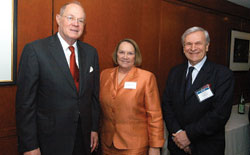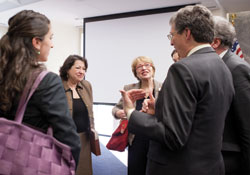A Historic Conversation
GW Law hosts a landmark meeting of the U.S. Supreme Court and the European Court of Human Rights.
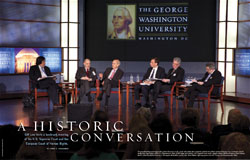
The groundbreaking event began with a panel discussion on the courts' roles within their respective judicial and political systems featuring (l to r) moderator Harold Hongju Koh, legal adviser at the U.S. Department of State, ECHR Judge Lech Garlicki, U.S. Supreme Court Justice Stephen Breyer, GW Law Professor David Fontana, Queen's University Belfast Professor J. Christopher McCrudden, and the Hon. Derek Walton, legal counselor to the U.K. Foreign and Commonwealth Office.
Four U.S. Supreme Court justices and seven members of the European Court of Human Rights gathered at GW Law School this spring for a historic summit focusing on issues relevant to both courts.
The first-ever official meeting between the two courts was held in cooperation with the U.S. Department of State's Office of the Legal Adviser. The daylong event featured a series of panel discussions on the courts' roles within their respective judicial and political systems, institutional challenges, freedom of expression, and extraterritoriality.
Justices Anthony Kennedy, Stephen Breyer, Samuel Alito, and Sonia Sotomayor participated in the conference, along with President of the European Court of Human Rights Sir Nicolas Bratza, Vice President Françoise Tulkens, former President Jean-Paul Costa, Judges Lech Garlicki and Nina Vajiÿ, Registrar Erik Fribergh, and Deputy Registrar Michael O'Boyle. Legal scholars and policymakers rounded out the discussion.
"On behalf of President Obama and Secretary Clinton, I am honored to welcome you to this historic event," said Harold Hongju Koh, legal adviser to the U.S. Department of State, during opening remarks. "We hope this conference will be the first of many such dialogues between these two extraordinarily important judicial institutions."
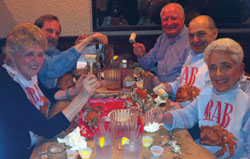
The ECHR delegation joined GW Law Professor Alan Morrison for a traditional mid-Atlantic crab feast during their visit.
U.S. Secretary of State Hillary Rodham Clinton greeted participants via video message. "Today's conference provides an important opportunity for justices and scholars to address issues that affect these two courts and judicial systems the world over," she said. "The United States and Europe share deeply rooted, common convictions about the importance of advancing democracy, the rule of law, and fundamental rights. Courts around the world increasingly look to the decisions of these two courts, making your engagement all the more crucial."
While the majority of the day's discussions were closed door so that dialogue could be promoted, the first panel was open to the public. The two-hour discussion, featuring U.S. Supreme Court Justice Breyer and Judge Garlicki of the European Court of Human Rights, focused on the similarities and differences between the two courts and how those differences affect the way the courts interpret issues.
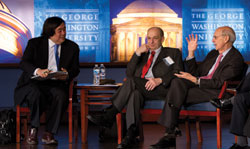
Supreme Court Justice Stephen Breyer (right) makes a point during the morning panel discussion as moderator Harold Hongju Koh (left) and Judge Lech Garlicki look on.
Both judges addressed freedom of religion—a hot topic in Europe following the European Court's March ruling in Lautsi v. Italy that the requirement to display crucifixes in classrooms of state schools in Italy did not violate the European Convention on Human Rights.
Judge Garlicki said the case's outcome might have been different if placed in a U.S. court. "We do not have an establishment clause in our Convention," he explained. "We have a free-exercise clause." The judge emphasized that the court is "not the Supreme Court of the United States of Europe. Our court is a court of universal standards, but we usually leave some white area—a margin of appreciation—for our 47 independent member states to decide how to implement the court's rulings."
"Religion is very divisive, based on moral principle, and very hard to compromise," said Justice Breyer in response to the case, pointing out that there are some 50 organized religions in the United States alone. "We need a document that allows these 50 religions to live together in freedom."
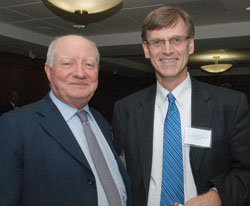
Former ECHR President Jean-Paul Costa with GW Law Professor Sean Murphy
Derek Walton, legal counselor to the United Kingdom Foreign and Commonwealth Office; J. Christopher McCrudden, professor of human rights and equality law at Queen's University Belfast and the William W. Cook Global Law Professor at the University of Michigan Law School; Legal Adviser Harold Koh; and GW Law Professor David Fontana also participated in the morning panel.
"It's quite striking, but not surprising, how the U.S. Supreme Court and the European Court of Human Rights can approach similar cases in such different ways," Mr. Walton said. "These are two very different courts carrying out very different functions. They are each respected for their different roles."
In welcoming remarks, former Law School Dean Paul Schiff Berman pointed out that eight of the nine U.S. Supreme Court justices have visited GW this academic year. "We, as a law school, are engaged with the real world," he said. "One of the most important things we can contribute to the international arena is to provide a neutral, nonpartisan forum for discussion and debate among decision makers and policymakers that leads to actual solutions in the world."
After the panel discussions, Chief Justice of the United States John G. Roberts Jr. hosted the European delegation, GW Law faculty, and invited guests at a dinner at the U.S. Supreme Court. The dinner also included many members of the U.S. Supreme Court, former Supreme Court Justice Sandra Day O'Connor, and the clerk of the court.
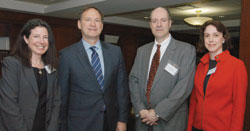
Justice Samuel Alito (second from left) with GW Law Professors (l to r) Laura Dickinson, Brad Clark, and Renée Lerner
"The conference, hosted in grand style by George Washington University Law School, explored common jurisprudential challenges, while allowing justices from each side to meet and get to know one another in less formal settings," Mr. Koh said. "The State Department Legal Adviser's Office was honored to help shepherd this historic first gathering of arguably the two most important rights courts in the world."
According to Associate Dean for International and Comparative Legal Studies Susan Karamanian, GW Law faculty members were instrumental to the conference's success. "Our human rights experts Professors Dinah Shelton and Ralph Steinhardt joined their international law colleagues Professors Laura Dickinson and Sean Murphy, as well as Professor David Fontana, a leading comparative constitutional law scholar, in fostering the dialogue between the two courts."
Associate Dean Karamanian added that "the event gave GW Law students the rare opportunity to listen to leading U.S. and European judges and scholars, and it enabled the students to understand the value of a comparative perspective to legal issues."
|
|

